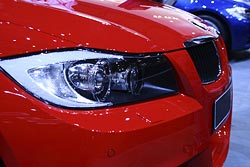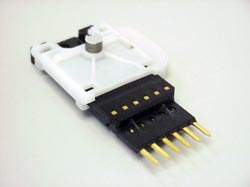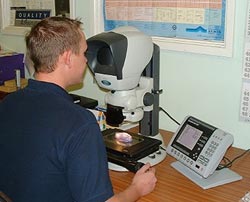Manufacturer of automotive, injection moulded components Thermoplastic Systems Engineering Limited (TSE) can prove their insert moulded components are being produced within exacting tolerance specifications.
Feature rich components are hard to measure with a gauging CMM, but using a Kestrel, optical 2-axis non contact measuring system, TSE can prove their manufacturing processes produce accurate mouldings.
 Thermoplastic Systems Engineering Limited (TSE) is based in Suffolk and manufactures a wide range of injection moulded and insert moulded plastic components. Predominantly supplying the automotive and aerospace industry, TSE provide a comprehensive service in manufacturing tight tolerance, feature rich moulded plastic components.
Thermoplastic Systems Engineering Limited (TSE) is based in Suffolk and manufactures a wide range of injection moulded and insert moulded plastic components. Predominantly supplying the automotive and aerospace industry, TSE provide a comprehensive service in manufacturing tight tolerance, feature rich moulded plastic components.
TSE manufacture from the full range of engineering and technical polymers and thermoplastic elastomers. Advanced materials, technology and planned development programmes are implemented to provide optimisation of component parts.
Development programmes consist of several stages and include applying computerised flow and cooling simulations to parts at the tool design stage to predict stress and deformation. This and other specialised stages of the production process are all part of the comprehensive service that TSE offer their clients.
Accuracy proves imperative on manufacturing process of the throttle sensor
One of TSE’s speciality areas exist in insert moulding. Insert moulding allows the combination of metal stampings or turned parts to be incorporated into complex geometry formed by the plastic. This allows for conductive paths, springs, or bearing surfaces to be combined into a single multi-functional component.
A primary component manufactured by TSE using the insert moulding process is a sensor that attaches to a throttle pedal. It utilises sensor technology instead of conventional cables. The mould has a printed circuit board (PCB) inserted which detects movement. When the linear movement is detected it opens up the butterflies on the throttle valves on the engine.
 Initially, when the throttle sensor was in the infancy of its manufacture, there was thought to be a discrepancy by the client, in the dimensional accuracy. This was due to drag when the throttle sensor substrate was mated with the white linear throttle slide. When the two components are mated the movement was designed to be smooth and slick but instead the drag was preventing this from occurring successfully.
Initially, when the throttle sensor was in the infancy of its manufacture, there was thought to be a discrepancy by the client, in the dimensional accuracy. This was due to drag when the throttle sensor substrate was mated with the white linear throttle slide. When the two components are mated the movement was designed to be smooth and slick but instead the drag was preventing this from occurring successfully.
The client suggested the discrepancy was due to the inaccuracy of the flex after measuring the dimensions with a contact gauging system.
Considering the dimensions and the intricate nature of the gold plated nickel legs, it was not surprising that the sensor on the contact measuring system was providing conflicting results.
After investigating the suggestion by the client, TSE found that the inaccuracies causing the slide to drag was down to a completely different reason.
The manufacturing process of the throttle sensor involved the client sending the components to be printed with carbon inks. This process involves curing the ink at 220ºc for 12 to 16 hours but, within the transition period of curing, the ink was expanding causing the thickness to increase, thus causing the slider to drag on the throttle substrate.
It was down to the accuracies of the non-contact measuring system from Vision Engineering that enabled TSE to prove to their client, that the drag was down to the expanded ink and not the insert moulded component being manufactured outside the tolerance range.

The Kestrel accurately repeats and reproduces the measurements
Peter Neille, Commercial and Technical Director explains how the 2 axis Kestrel from Vision Engineering has proven to be a more than an investment.
“The Kestrel has provided our engineers with the ability to accurately repeat and reproduce the measurements of gauging points on plastic injection moulded and insert moulded components. The accuracy and ease of use of the Kestrel system allows for our engineers to make quick and easy measurements.”
“Components that are feature rich often can not be measured by a CMM gauging system because the features are very delicate and it is hard to sustain accurate repeatability. However, the Kestrel non contact measuring system has consistently provided accurate measurement, to the extent that we have been able to prove to our clients that our batches of commissioned injection moulded and insert moulded parts are manufactured within tolerance specifications.”



